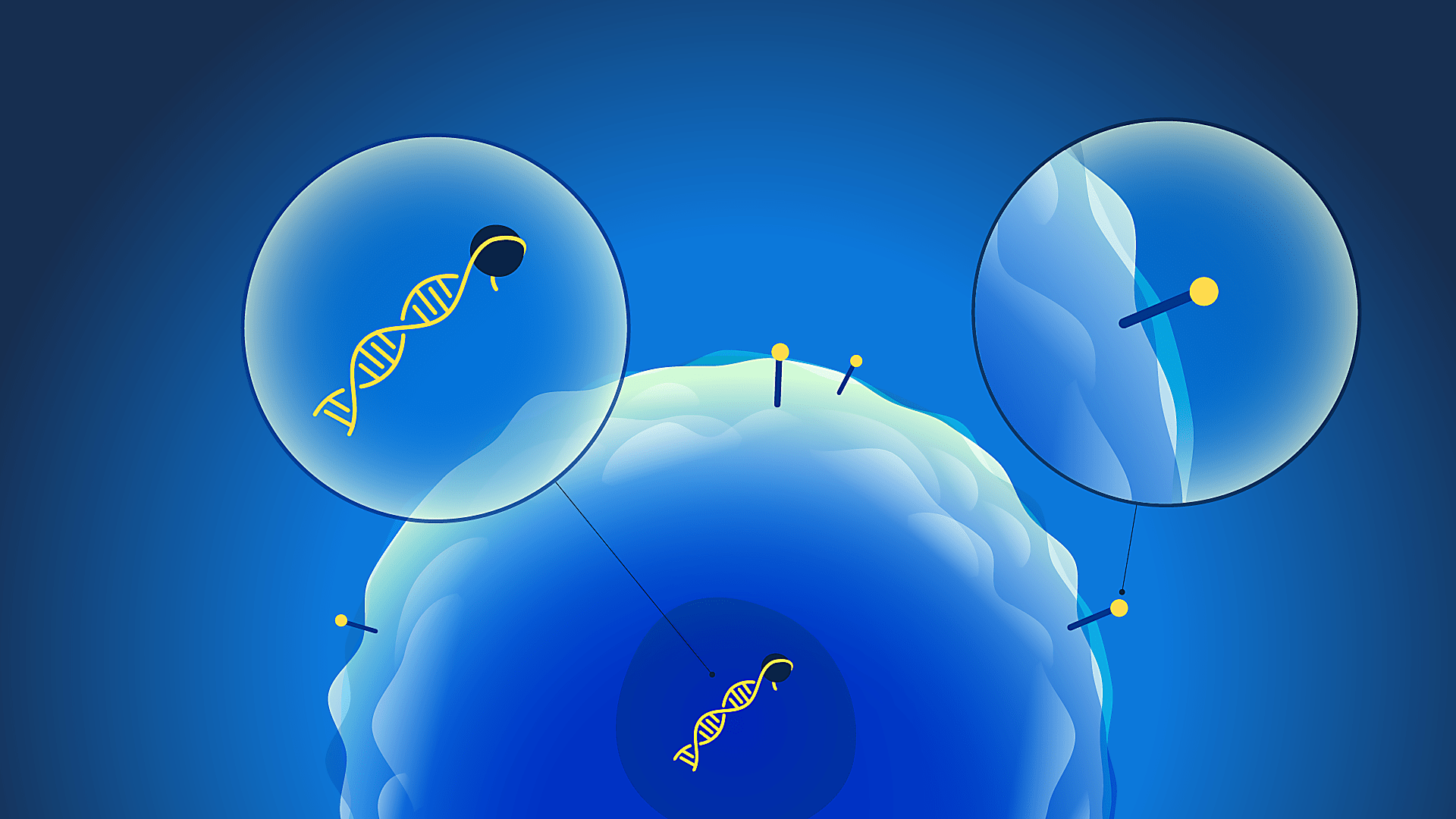PHAGE-ATAC: Researchers elevate ATAC-seq with simultaneous chromatin accessibility and protein profiling
The Innovator Blog Series celebrates research conducted by 10x Genomics customers who have demonstrated scientific ingenuity by adapting Chromium Single Cell or Visium Spatial sequencing-based assays. These innovations are distinguished by their originality and potential impact on scientific discovery, including providing access to novel analytes, advancing multiomic analysis techniques, and demonstrating critical applications to human health and disease. These techniques are customer developed, meaning they are not officially supported by 10x Genomics.
Multimodal single cell analysis is a powerful tool, enabling scientists to study the transcriptome, the epigenome, and cell surface proteins on a cell by cell basis. However, current technologies employ oligonucleotide-barcoded antibodies, which presents challenges to throughput and study design. Because the number of antigens that can be targeted by antibodies is limited, scientists need a higher-throughput, scalable version of this system. In the latest installment of our Innovators Series, where we discuss creative applications of existing 10x Genomics solutions, learn more about how scientists tweaked our Single Cell ATAC (Assay for Transposase Accessible Chromatin) solution, using nanobody-displaying phages to profile both chromatin accessibility and cell surface protein expression at scale and with high specificity. We also review their application of this advanced method to detect the SARS-CoV-2 spike protein in human cell populations.

While innovations typically involve developing new tools to solve previously unforeseen problems, sometimes deconstruction is at the heart of the process. Given a tool with the potential to drive innovation, scientists may be able to take it apart and put it back together in a new, different way, driving not only innovation, but possibly a game-changing research method. Recently published research (1) led by Evgenij Fiskin, PhD, a postdoc in the lab of Aviv Regev, PhD, at the Broad Institute of MIT and Harvard, can be called such an innovation. His PHAGE-ATAC method puts a new spin on our Single Cell ATAC + Feature Barcode for cell surface protein detection solution by substituting oligo-barcoded antibodies with phage-expressing, engineered, camelid single-domain antibodies, or “nanobodies” (2). In essence, the authors show that a phage-based approach can be successfully used to measure cell surface protein expression and chromatin accessibility as well as intracellular proteins and mtDNA genotype. One of the outstanding advantages of this application, they show, is that not only are nanobodies small and stable, but this approach can be scaled for high-throughput, highly specific and sensitive single cell profiling studies.
In PHAGE-ATAC, nanobody (Nb)-displaying phages bind to cell surface protein epitopes instead of oligonucleotide-conjugated antibodies (CITE-seq) or fluorescently-labeled antibodies. A cell is bound by a Nb expressed by a phage vector, which then inserts into the cell along with a genetic barcode prior to the ATAC protocol. They explain: “The hypervariable complementarity-determining region 3 (CDR3) within each Nb-encoding phagemid acts as a unique genetic barcode (3) that is identified by sequencing in PHAGE-ATAC, and serves as a proxy for antigen (or, cell surface protein, in this case) detection and quantification.” So, essentially, in this modified scATAC-seq, GEM barcodes can be traced back to open chromatin DNA regions, while the barcode within the phagemid can be traced back to identify the nanobody that it was engineered to express.
Phage-based profiling of both chromatin accessibility and protein expression
After verifying that their method worked using HEK293T cells expressing a glycosylphosphatidyl-inositol (GPI)-anchored, enhanced green fluorescent protein (EGFP) (EGFP-GPI), they applied it to a “species-mixing” experiment in order to benchmark the method for single cell profiling. For this part of the study, they mixed mouse and both human EGFP− (HEK293T) and human EGFP+ (HEK293T-EGFP-GPI) cells, followed by anti-EGFP phage-Nb staining, library preparation, and analysis. The recovered mouse and human cell barcodes were comparable to reference data in terms of protein detection, and when they compared protein detection using their ATAC method versus flow cytometry, they found similar results. Additionally, after lysing the cells and then staining, they were able to quantify expected levels of intracellular protein.
Next, by combining PHAGE-ATAC with another method called PHAGE-ASAP, or select antigen profiling (a combined workflow for staining with both phage-Nbs and oligo-labeled antibodies), they further expanded their ability to profile cells, in this case, peripheral blood mononuclear cells (PBMCs). Pairing these two methods allowed PHAGE-ATAC to measure accessible chromatin, surface epitopes, and mitochondrial genotypes all at once.
Measuring SARS-CoV-2 epitopes with phage-Nbs
When it comes to detecting new antigens, such as for identifying SARS-CoV-2 variants, a renewable source of specific antibodies that could also permit high-throughput analysis would be a boon for researchers. In the final part of Dr. Fiskin’s study, he and his team focused on the SARS-CoV-2 spike protein (SARS-CoV-2-S), first generating a “synthetic high-complexity phage-Nb library” and then choosing the top seven phage-Nbs that showed the highest signal for PHAGE-ATAC. From these, they constructed a panel of seven anti-SARS-CoV-2-S Nbs, two anti-EGFP Nbs, and three PBMC-recognizing pNbs (anti-CD4, CD8, and CD16), and then used PHAGE-ATAC to profile PBMCs, SARS-CoV-2-S+ HEK293T cells, and EGFP-GPI+ HEK293T cells. Their recovered cell barcodes showed expected ratios of both cell types and expected cell states. They also detected the entire panel of phage-Nbs. Therefore, not only can PHAGE-ATAC be used to detect host antigens, it can find viral antigens as well using a panel of phage-Nbs.
PHAGE-ATAC for specific and scalable multimodal profiling
While this study demonstrates that using a renewable, scalable source of a library of phages expressing Nbs is highly specific and sensitive compared to traditional methods, Dr. Fiskin believes that the potential is wide-ranging. Their method will allow for “ultra-highly multiplexed epitope” profiling as well as future studies of solid tumors. In general, they predict that recombinant reagents like nanobodies will further advance single cell multimodal studies, enabling improved specificity and higher throughput.
Learn more about PHAGE-ATAC by reading the publication →
References:
- Fiskin E, et al. Single-cell profiling of proteins and chromatin accessibility using PHAGE-ATAC. Nat Biotechnol (2021). Online ahead of print. doi: 10.1038/s41587-021-01065-5
- Ingram JR, Schmidt FI & Ploegh HL. Exploiting nanobodies’ singular traits. Annu Rev Immunol 36: 695–715 (2018). doi: 10.1146/annurev-immunol-042617-053327
- Pollock, S. B. et al. Highly multiplexed and quantitative cell-surface protein profiling using genetically barcoded antibodies. Proc Natl Acad Sci USA 115: 2836–2841 (2018). doi: 10.1073/pnas.1721899115
